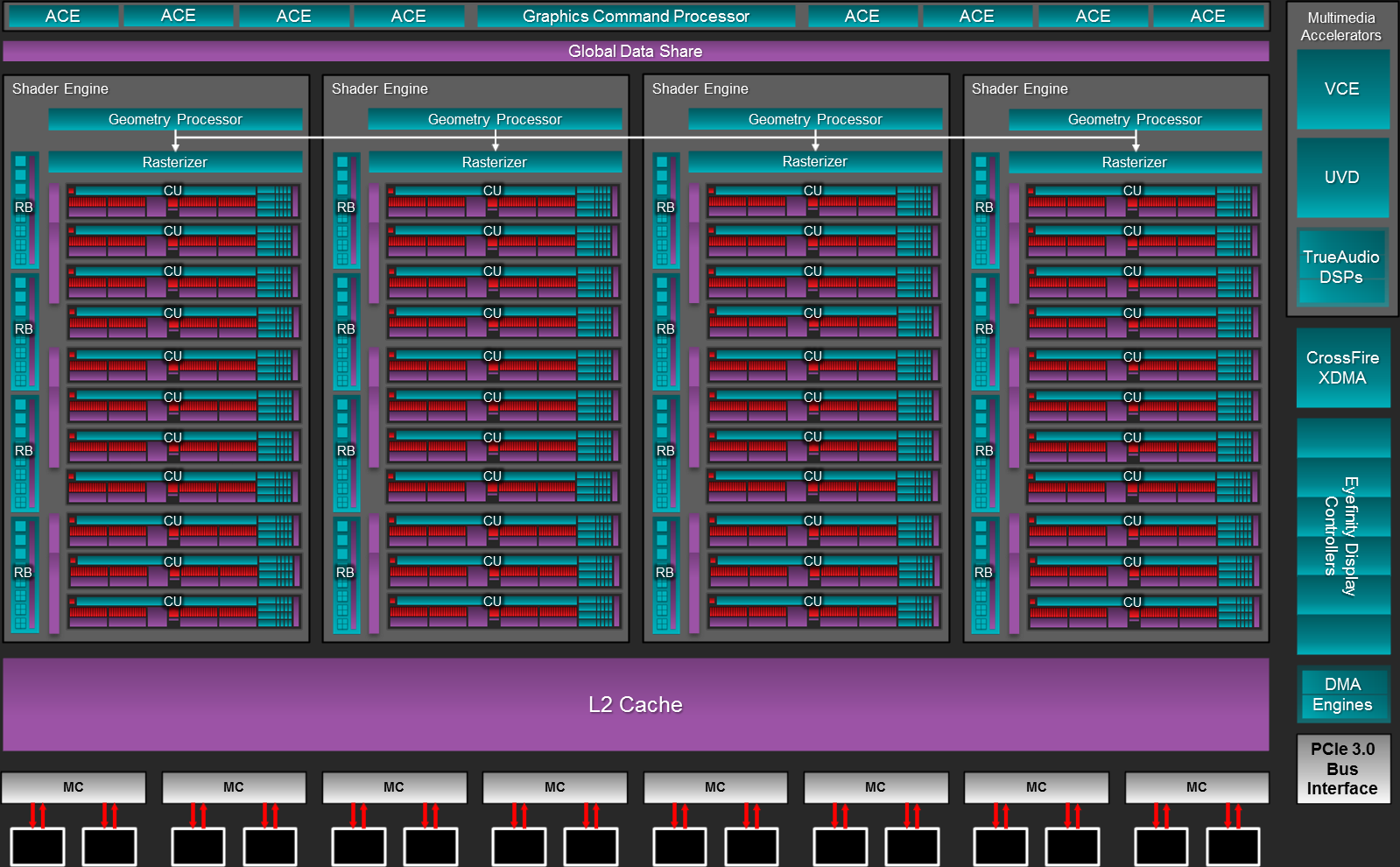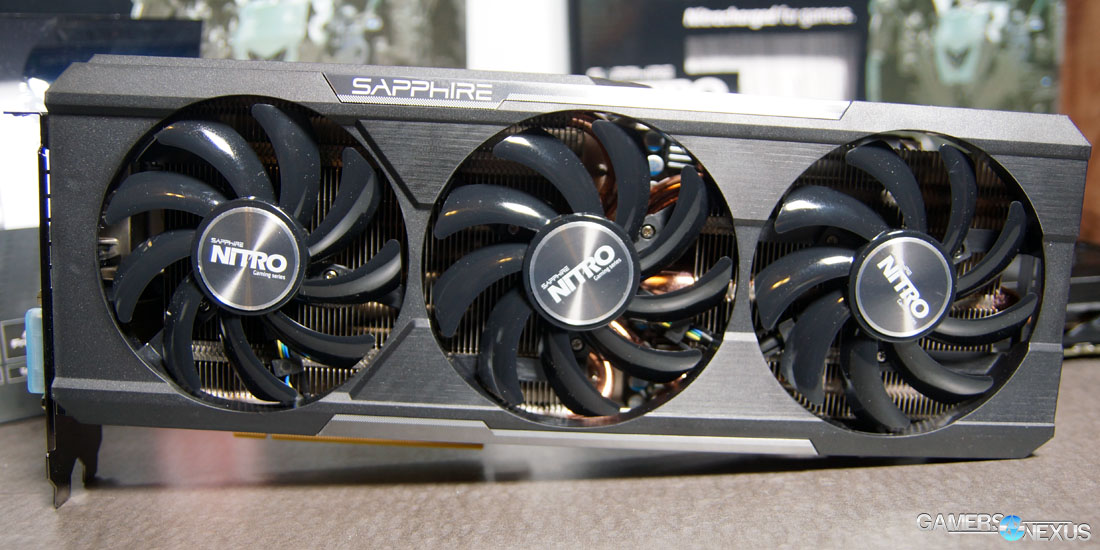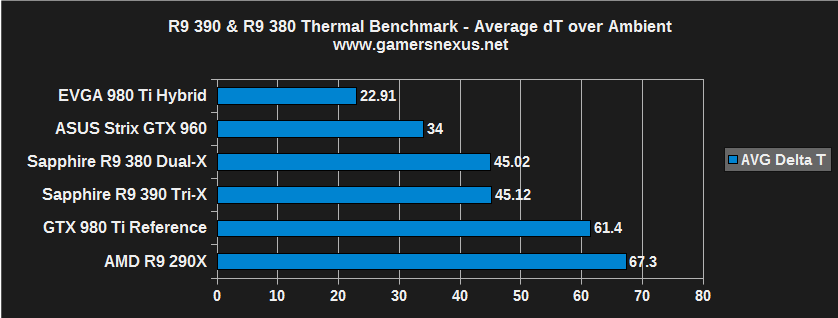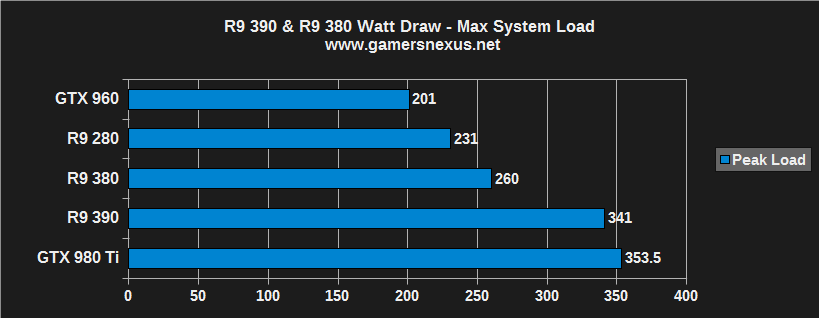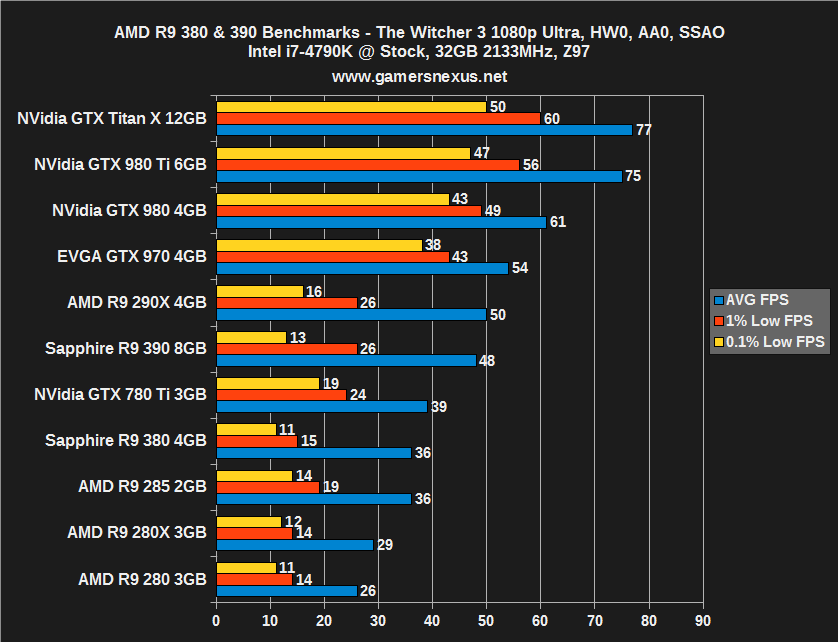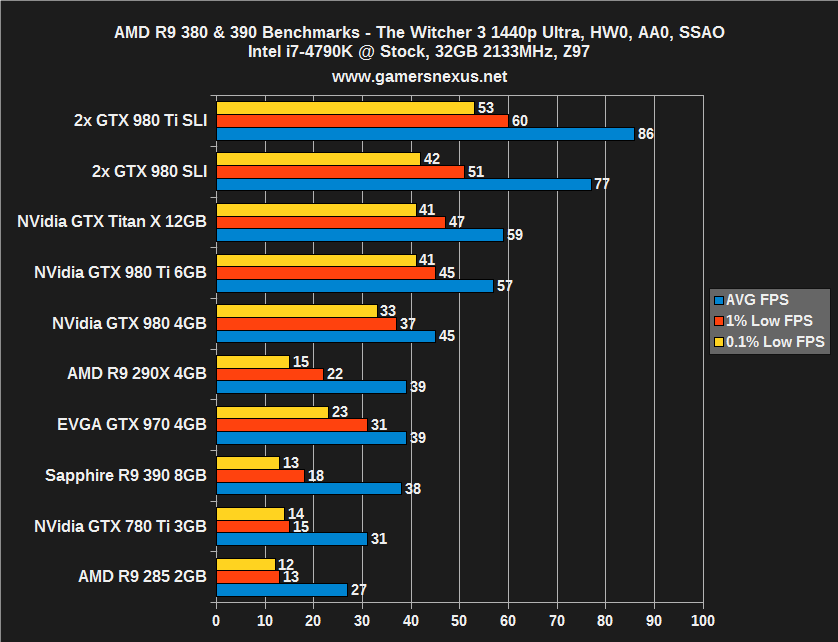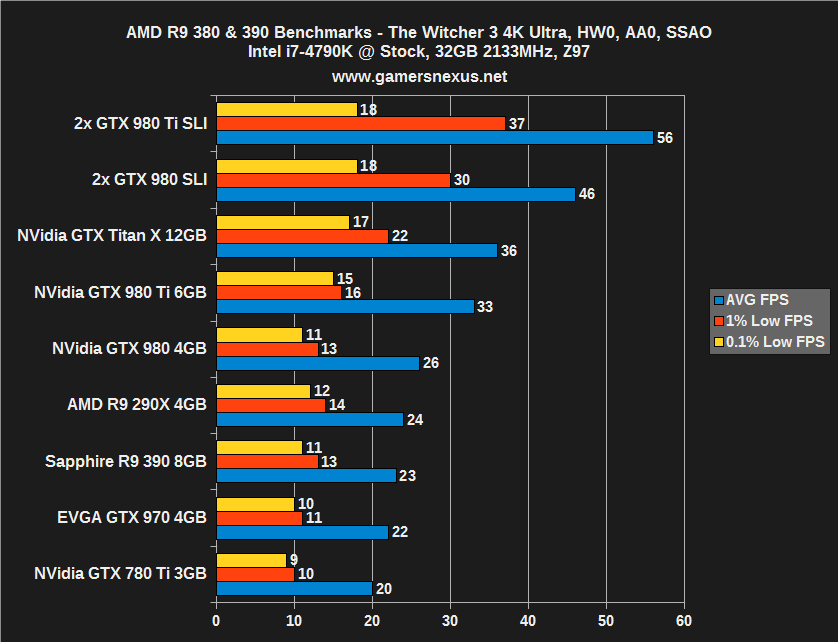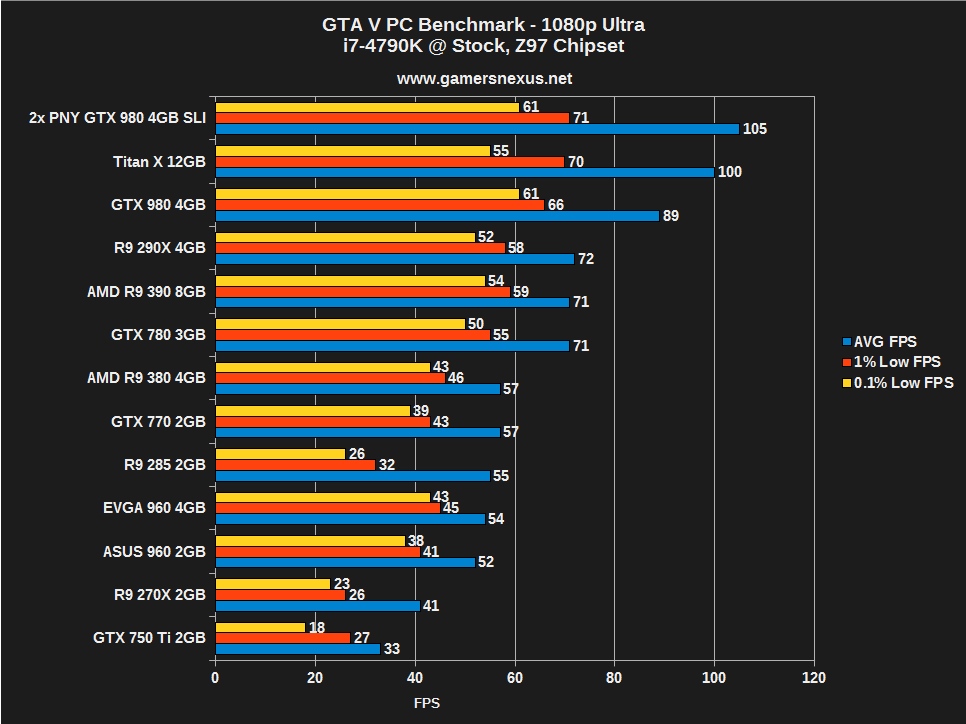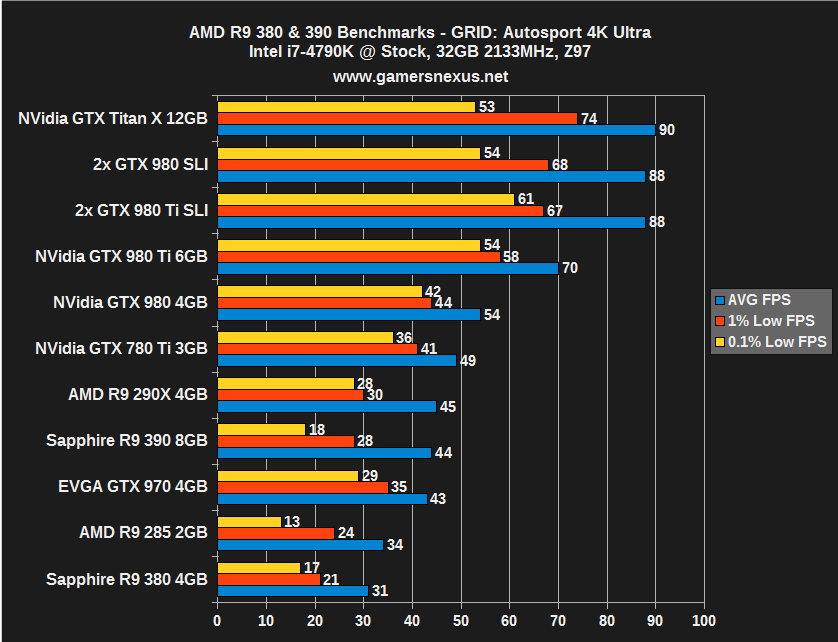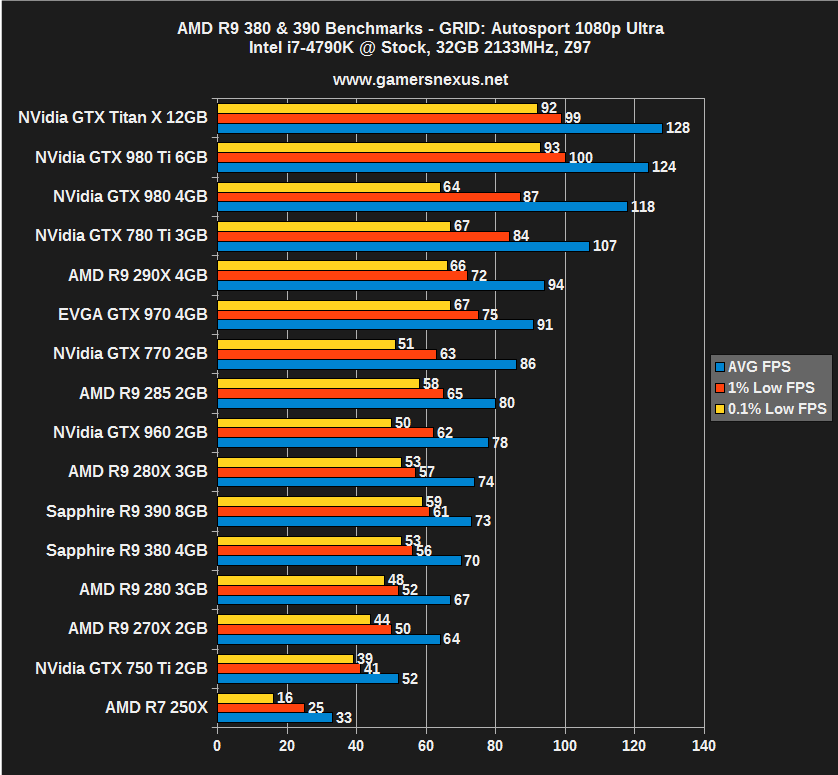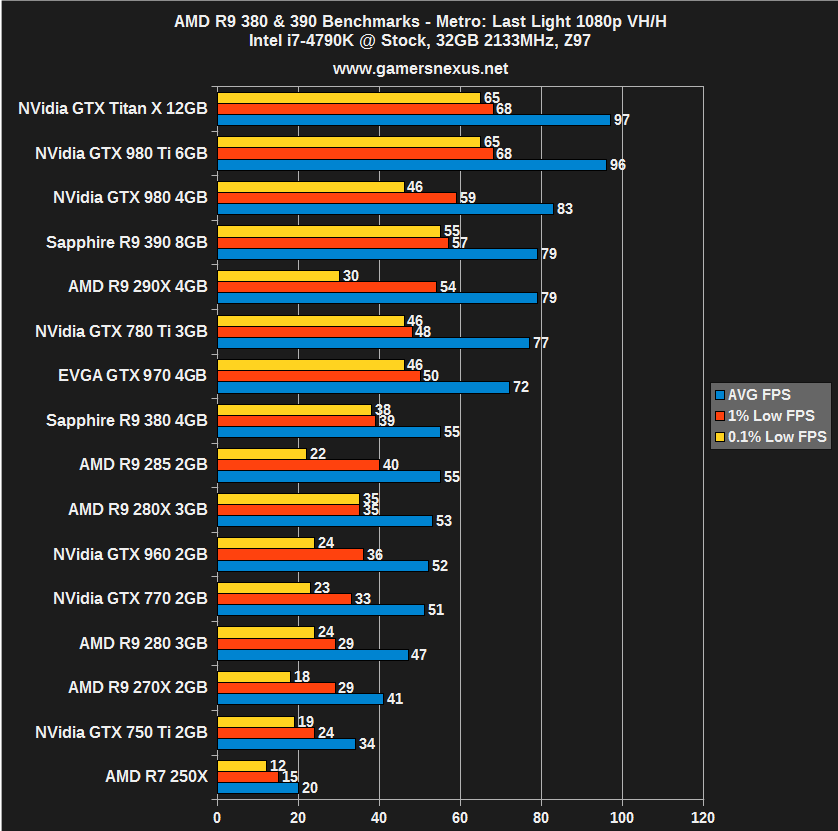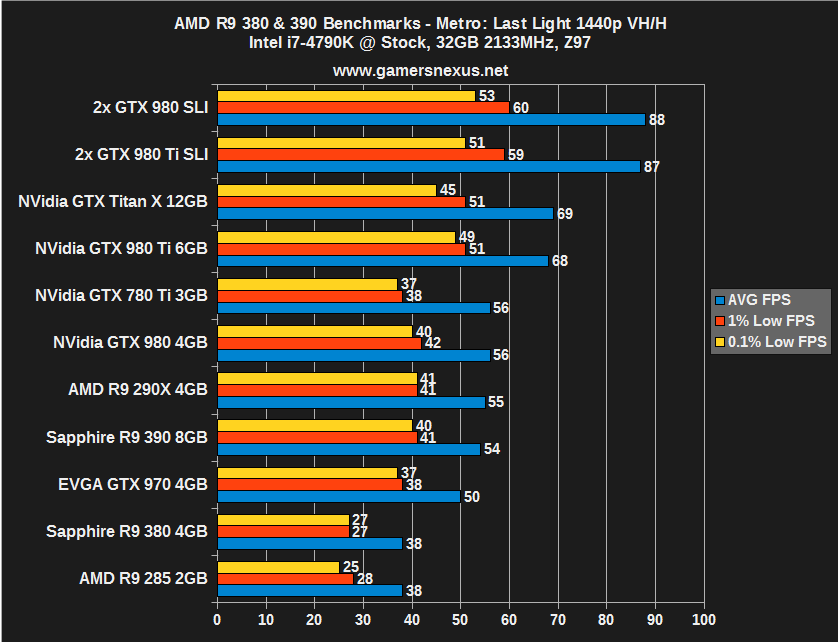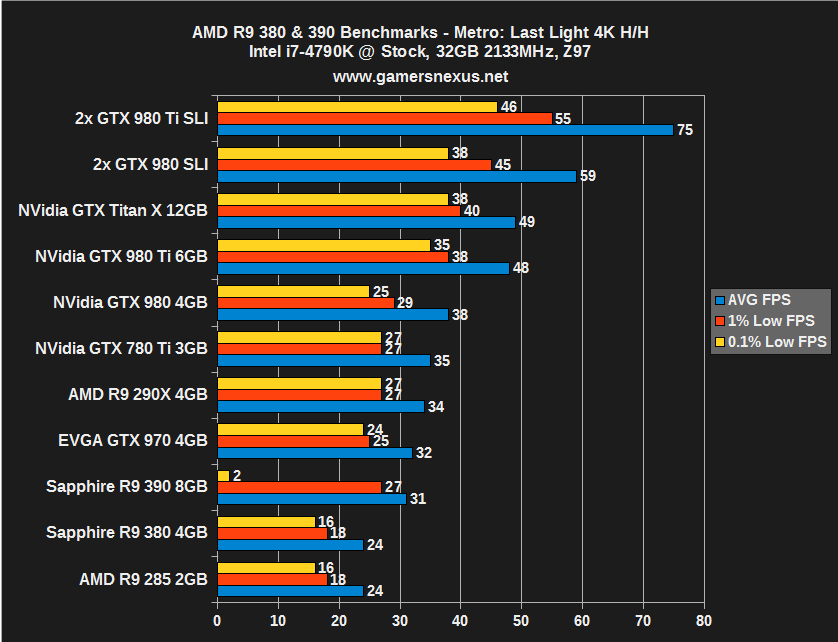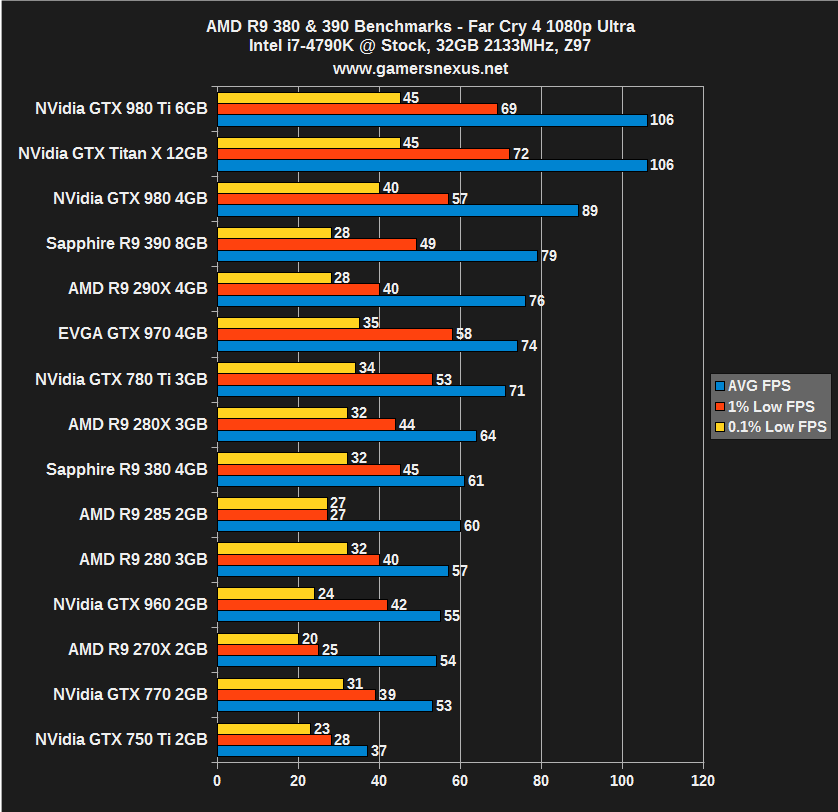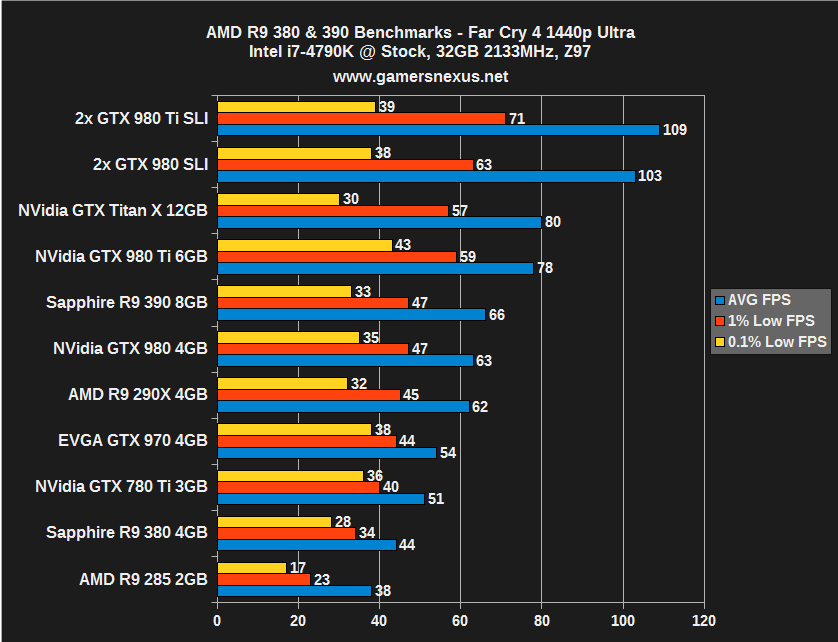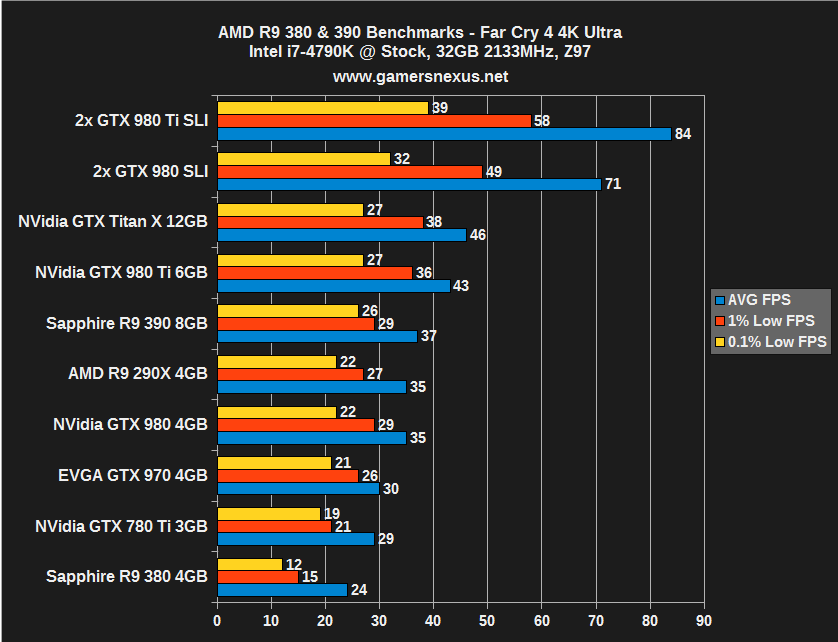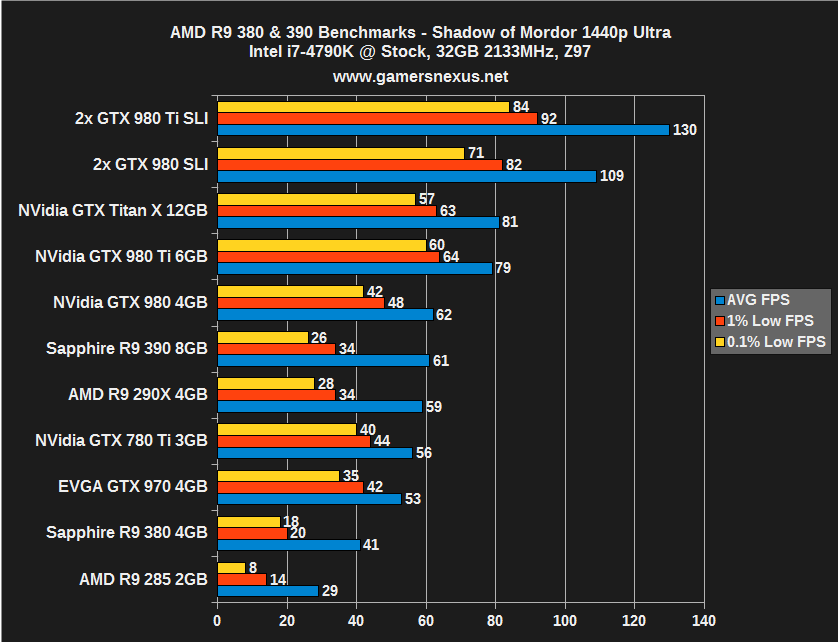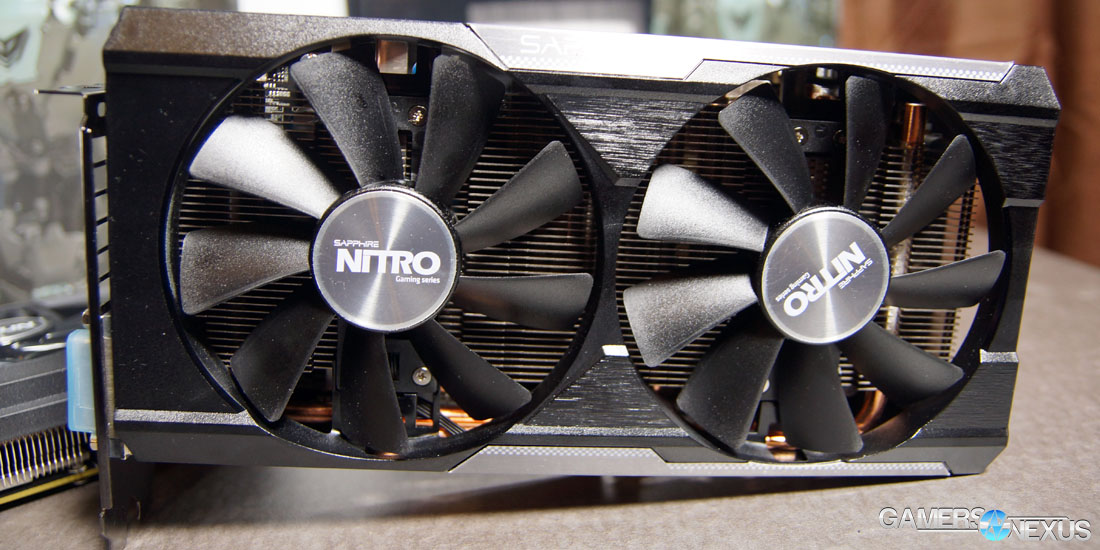AMD's most recent video card launch was September of 2014, introducing the R9 285 ($243) on the slightly updated Tonga GPU. Tonga was laterally imposed to take the place of the Tahiti products, namely the HD 7970 and its refresh, the R9 280. The Radeon 7970 video card shipped in late 2011 on the Tahiti GPU, a die using TSMC's still-fabbed 28nm process, and was refreshed as the R9 280, then updated, improved, and refreshed again as the Tonga-equipped R9 285. At its core, the 285 would offer effectively identical on-paper specs (with some changes, like a 256-bit memory bus against the 384-bit predecessor), but introduced a suite of optimization that yielded marginally improved performance over the R9 280.
All of this is to say that it's been a number of years since AMD has introduced truly new architecture. Tahiti's been around four years now, Hawaii shipped in 2013 and was a node refresh of Tahiti (more CUs, ROPs, and geometry / rasterizer processors), and Fiji – the anticipated new GPU – won't ship for a short bit longer. Filling that space is another refresher line, the Radeon 300 series of video cards.
AMD's lull in technological advancement on the hardware side has allowed competitor nVidia to increase competition in some unchallenged market segments, like the high-end with the GTX 980 Ti ($650) and mid-range with the GTX 960 ($200). The long-awaited R9 300 series video cards have finally arrived, though, and while they aren't hosting new GPUs or deploying a smaller fab process, the cards do offer marginally increased clockrates and other small changes.
This review benchmarks the AMD R9 390 and AMD R9 380 graphics cards against the preceding R9 280, R9 290(X), GTX 960, and other devices. The R7 370 and R7 360 also launch today, but won't be reviewed here.
AMD R9 390X, R9 390, R9 380, R7 370, & R7 360 Specs
| AMD R9 390X | AMD R9 390 | AMD R9 380 | AMD R9 290 | AMD R9 280 | |
| Process | 28nm | 28nm | 28nm | 28nm | 28nm |
| Stream Processors | 2816 | 2560 | 1792 | 2560 | 1792 |
| Boosted Clock | 1050MHz | 1000MHz | 970MHz | 947MHz | 933MHz |
| COMPUTE | 5.9TFLOPs | 5.1TFLOPs | 3.84TFLOPs | 4.89TFLOPs | 2.96TFLOPs |
| TMUs | 176 | 160 | 112 | 160 | 112 |
| Texture Fill-Rate | 184.8GT/s | 160GT/s | 108.64GT/s | 152GT/s | 92.6GT/s |
| ROPs | 64 | 64 | 32 | 64 | 32 |
| Pixel Fill-Rate | 67.2GP/s | 64GP/s | 31.04GP/s | 64GP/s | 26.5GP/s |
| Z/Stencil | 256 | 256 | 128 | 256 | 128 |
| Memory Configuration | 8GB GDDR5 | 8GB GDDR5 | 2 & 4GB GDDR5 | 4GB GDDR5 | 3GB |
| Memory Interface | 512-bit | 512-bit | 256-bit | 512-bit | 384-bit |
| Memory Speed | 6Gbps | 6Gbps | 5.5-5.7Gbps | 6Gbps | 5Gbps |
| Memory Bandwidth | 384GB/s | 384GB/s | 182.4GB/s | 320GB/s | 240GB/s |
| Power | 1x8-pin 1x6-pin | 1x8-pin 1x6-pin | 2x6-pin | 1x8-pin 1x6-pin | 2x6-pin |
| TDP | 275W | 275W | 190W | 275W | 200W |
| API Support | DX12, Vulkan, Mantle | DX12, Vulkan, Mantle | DX12, Vulkan, Mantle | DX12, Vulkan, Mantle | DX12, Vulkan, Mantle |
| Price | $430.00 | $330.00 | $200.00 | $264.00 | $170.00 |
Sapphire R9 390 & R9 380 Specs
The new 300-series of cards closely resembles the 200-series cards, utilizing the same years-old, matured architecture as found in the 290 and 280 cards. The core clock has been boosted slightly in the new series of cards – about 40-50MHz – and that's resulted in a slight boost to texture fill-rate (core clock * TMUs = texture filter rate). TDP is roughly the same at 275W for the *90 cards and ~190W for the *80 cards, power pin-outs are the same, and so forth.
Launch prices land lower than the initial pricing of the 200 series, but is still greater than the R9 200 series cards. The R9 390 launches for $330 and the R9 380 for $200, with the R9 290 available for roughly $264 (before rebates) and R9 280 available for $170 (before rebates). Both are accompanied by $20 MIRs depending on where they are bought.
Sapphire's “Nitro” branded gaming cards heavily market the affordable “gamer” market, a segment the company sees as hyper-focused on cost-effective gaming solutions that produce playable framerates.
This is normally where we'd spend a good deal of time discussing new architecture, but there's nothing new here. The 300 series uses tried-and-true Hawaii architecture, which resembles something like this:
The new 300-series cards support VSR, a feature that never made it to 200-series cards outside of the Tonga chips (R9 285) and 290X, despite promises contrary. We previously benchmarked VSR's scaling performance against DSR in this article.
AMD's Take: A Matured Design
AMD speaks big on Hawaii, Tonga, and Tahiti, despite their aging process and architecture. The company sees the architecture as “matured” and has indicated that this time has allowed for greater focus on optimizations to better take advantage of the hardware present. The company has continued to introduce new software into Catalyst – like its new frame limiter that's supposed to limit power consumption by capping framerates through drivers. The new limiter is branded as “Frame Rate Targeting Control” (FRTC).
FRTC isn't something we see getting practical use, but it's there. The reality is that, most likely, framerate will rarely exceed such a high output that it would be desirable to throttle the metric. Perhaps for older games or for the Fury cards, but it doesn't necessarily apply at the level we're reviewing today.
Sapphire's Take: A Gaming Card at Affordable Prices
Sapphire has spent considerable effort on its branding for the new AMD devices, labeling “gamer” class cards under a new “Nitro” branding initiative. The “Nitro” class devices will all be available around or below the $300 price-point, and emphasize offering enough power to game without venturing into overkill territory. The effort is admirable and, with an adequate web platform, could help less-informed buyers decide between the somewhat confusing lineup of SKUs between all vendors.
The AMD-exclusive board partner has also introduced its “Sapphire Nation” website, a content producing hub that hosts driver links, support and community forums, a card selection utility, and game optimization guides. Sapphire has expressed excitement about its venture into the games media space, producing regular podcasts and game streams for members of its community.
Sapphire-only servers are already hosted and access can be granted to participating community members.
The push to market gaming community organization and game-oriented value-adds corresponds with AMD's vocalized philosophy to sell “just enough” for gaming at high framerates. AMD continues to struggle in the thermal and TDP sectors, but levies that its focus is simply on fluid gameplay with lower – but present – regard for thermals and power draw.
We'll test AMD's ability to deliver its FPS promises on page 2.
Test Methodology
We tested using our updated 2015 GPU test bench, detailed in the table below. Our thanks to supporting hardware vendors for supplying some of the test components. Thanks to Jon Peddie Research for GTX 970 & R9 280X support.
The latest GeForce 353.06 drivers were used during testing. AMD Catalyst 15.15 was used for 300 series cards. Game settings were manually controlled for the DUT.
VRAM utilization was measured using in-game tools and then validated with MSI's Afterburner and AIDA64, a custom version of the Riva Tuner software. Parity checking was performed with GPU-Z. FPS measurements were taken using FRAPS and then analyzed in a spreadsheet.
Each game was tested for 30 seconds in an identical scenario on the two cards, then repeated for parity.
| GN Test Bench 2015 | Name | Courtesy Of | Cost |
| Video Card | Sapphire R9 380 | Sapphire | TBD |
| CPU | Intel i7-4790K CPU | CyberPower | $340 |
| Memory | 32GB 2133MHz HyperX Savage RAM | Kingston Tech. | $300 |
| Motherboard | Gigabyte Z97X Gaming G1 | GamersNexus | $285 |
| Power Supply | NZXT 1200W HALE90 V2 | NZXT | $300 |
| SSD | HyperX Predator PCI-e SSD | Kingston Tech. | TBD |
| Case | Top Deck Tech Station | GamersNexus | $250 |
| CPU Cooler | Be Quiet! Dark Rock 3 | Be Quiet! | ~$60 |
Average FPS, 1% low, and 0.1% low times are measured. We do not measure maximum or minimum FPS results as we consider these numbers to be pure outliers. Instead, we take an average of the lowest 1% of results (1% low) to show real-world, noticeable dips; we then take an average of the lowest 0.1% of results for severe spikes.
We conducted a large suite of real-world tests, logging VRAM consumption in most of them for comparative analysis. The games and software tested include:
- Far Cry 4 (Ultra 1080, Very High 1080).
- GRID: Autosport (Ultra 1440, Ultra 4K).
- Metro: Last Light (Very High + Very High tessellation at 1080; High / High at 1440).
- GTA V (Very High / Ultra at 1080p).
- Shadow of Mordor (Very High, 1080p).
- 3DMark Firestrike Benchmark
- GTA V
- The Witcher 3
We already know GTA V and Far Cry 4 consume massive amounts of video memory, often in excess of the 2GB limits of some cards. GRID: Autosport and Metro: Last Light provide highly-optimized benchmarking titles to ensure stability on the bench. Shadow of Mordor, GTA V, & The Witcher 3 are new enough that they heavily eat VRAM. 3DMark offers a synthetic benchmark that is predictable in its results, something of great importance in benchmarking.
Thermals were reported using Delta T over ambient throughout a 25-minute burn-in period using 3DMark FireStrike - Extreme on infinite loop, which renders graphics at 1440p resolution. This test loads the VRAM heavily, something Kombustor skips, and keeps the GPU under high load that is comparable to gaming demands. Temperatures were logged using AIDA64.
Critical Note: A Word on Driver Difficulties
No matter the benchmark results in the below charts, the R9 390 is not 4K-ready. Throughout our test period with the 300 series devices, the drivers have exhibited a number of blocking failures that diminish the quality of gameplay or obstruct it entirely. The 300 series launched with version 15.15 of AMD's Catalyst drivers, doing little to stabilize the previous two beta updates. The last stable driver update launched in December with Omega.
During testing, the R9 390 regularly produced black flickering on the display at all game resolutions, but they occurred most frequently at 4K. This flickering issue also presented itself at the desktop level and would occasionally lose the display signal entirely. Requiring a cable pull for detection. We've got more than twenty video cards on the bench, and this is the only one that presents such an issue. The black 'flickers' appear a minimum of twice per minute with an average 'hold' time of 5 seconds. The issue is more pronounced at 1440p and 4K. We have deemed this defect severely prohibitive to gameplay and would consider games “unplayable” while the problem persists.
The R9 380 and R9 390 both have issues gaming at 4K, even when framerates are somewhat reasonable (see - GRID: Autosport), regularly failing to draw textures as more than a black fill on the assigned geometry.
Installation was another issue. Our install of the 300 series drivers did not appear compatible with the 200 series, something we hope is fixed as users receive their cards. The 300 series drivers do not install atop the old drivers (and will present conflicting reports in the 'about' information as to the driver version) and will sometimes struggle with clean installs if Windows Update is enabled to fetch drivers. This is the nature of drivers that aren't WHQL verified, but the 300 series presented more installation difficulties than most other drivers we've recently worked with. Nuking the drivers with Driver Remover can create some issues with boards that utilize multiplexed PCI-e downstream switches, something we provided a fix guide for here.
AMD R9 390 & 380 Temperatures & Power Consumption
Our samples deploy Sapphire-designed Tri-X and Dual-X coolers, so performance will excel beyond what the old reference 200 series coolers were capable of. AMD is known for running hot, but Sapphire cools the chips impressively well – granted, the R9 390 Tri-X card is massive at 12.5” long.
Power draw is about what we'd expect. The *90 series draws in excess of 300W (total system load), *80 in the 350-360W range (total system load), and – for comparison – the GTX 960 draws around 200W, but is significantly lower powered in its raw framerate output.
AMD R9 390 & 380 vs. 290X, 280 – The Witcher 3 Benchmark
Results produced in the Witcher 3 were effectively unplayable at 4K, but that's not saying much – it's a hard game to run, as evidenced by the fact that a Titan X still doesn't enter the “playable” range of performance without fine-tuning the graphics settings. Moving to more common resolutions, 1440p gaming is still just out of reach of the R9 390 and R9 380, but 1080p is a different story. With Ultra settings, the R9 390 produces a 48FPS average output – approaching playable range and easily increased by lowering foliage viewing detail – but sustains a somewhat dismal 13FPS 0.1% low. 99- and 99.9 percentile performance suffers on the new card, shown in the way of somewhat choppy frametimes in the temporal charts.
The R9 380 would need to be dropped to medium settings for reasonable playability, where we saw an unlisted average of 56FPS, 1% low of 37FPS, and 0.1% low of 15FPS.
For the price, the R9 390 appears competitive with nearby alternatives – the GTX 970, mainly – but isn't something we can recommend until the black flickering sorts itself out. The R9 290X is available at roughly the same price that the R9 390 is intended to ship at and exhibited better driver stability. At $325, the 290X is still a reasonable buy for when nVidia is priced out of the build.
AMD R9 390 & R9 380 GTA V Benchmark
AMD R9 390 & 380 vs. 290X, 280 – GRID: Autosport Benchmark
AMD R9 390 & 380 vs. 290X, 280 – Metro: Last Light Benchmark
AMD R9 390 & 380 vs. 290X, 280, 960 – Far Cry 4 Benchmark
As with the above, no one's going to be playing Far Cry 4 at 4K with anything short of a >$500 graphics configuration. Dropping to 1080p, the R9 380 pushes a desirable ~60FPS with agreeable lows, flanked only by the 280X and 285. The GTX 960 and R9 270X fall slightly behind.
AMD R9 390 & 380 vs. 290X, 280, 960 – Shadow of Mordor Benchmark
Playing Shadow of Mordor at 1080p with ultra settings sees playability on the R9 380 and R9 390, sitting at 58FPS and 78FPS averages, respectively. The GTX 970 lands between the two, but would be a significantly better buy than the R9 390 while it has driver issues.
Conclusion: A Disappointing Re-Refresh
AMD's put themselves into a weird cycle of partial refreshes. Fury will be a breath of (hopefully) fresh air, but for now, there's little to be excited about for those who've followed the 7000 and R9 200 series launches. The R9 380 produces marginally better performance than our R9 280 – depending on the game, we're in the ~4% range favoring the 380 – and otherwise operates equivalently. We don't have an R9 290, but the core-advantaged 290X trades blows with the R9 390 and is priced almost identically after factoring rebates and other discounts found on Newegg.
From the specs and our own benchmarks, it would appear that owners of the R9 200 series have no incentive to migrate to the new R9 300 refresh. The R9 285 and R9 380 are priced and perform similarly, but if either one dips below the other in price, it's a reasonable mid-range buy for system builders trying to spend somewhere between 750 Ti and 970 “land” in terms of price. The GTX 960 ($200) is still a good card for its low TDP package, driver support, and software feature-set, but doesn't push the highest raw framerate for some of the harder-hitting modern games.
The R9 390 isn't a device we can recommend right now. Once the black flickering is resolved, it'd be a consideration, but I'd feel a lot more confident recommending that readers spend an extra few bucks toward a more driver-stable GTX 970. The R9 290 ($235 after rebate) is priced cheaper than the R9 390, though, and will perform within 3-6% of the newer card; we'd just buy that instead, really.
AMD's poor showing of driver support has made it difficult to recommend the company's cards even when they're able to push a reasonable framerate. The new devices are OK for the price, but not exciting. NVidia holds a clear and obvious day-1 driver advantage, showing a track record of game-ready, verified drivers on launch day where AMD has failed to compete. For builders who are comfortable waiting an extra day or two on game-ready drivers, the price decrease for AMD can be worthwhile – especially in the mid-range and entry-level markets. At the high-end, nVidia still reigns king with the 980 Ti and 980, though Fury could change things.
NVidia still consumes fewer Watts, no news there, but we were markedly impressed with Sapphire's cooling ability on the 300-series cards. A 45C Delta T over Ambient value is a substantial thermal improvement over our 290X reference card (67C) and talks AMD away from the thermal ledge a little bit. The Tri-X is a massive 12.5” long, but cools well and is worthy of note for its ability to dissipate 275W of heat.
AMD and its board partners are all driving the same angle: For gamers who don't care about additional features -- like CUDA-accelerated application support or a heavier focus on power savings and thermal reduction -- the R9 300 cards are AMD's go-to device. AMD wants to sell to users who care first and foremost about FPS, with little regard for TDP and temperature so long as it's cheap and games. The company needs to get its drivers in order before we can confidently recommend any 300-series products, but it is possible for them to achieve the angle they're targeting -- it's just going to require more joint software-hardware effort.
- Steve “Lelldorianx” Burke.
